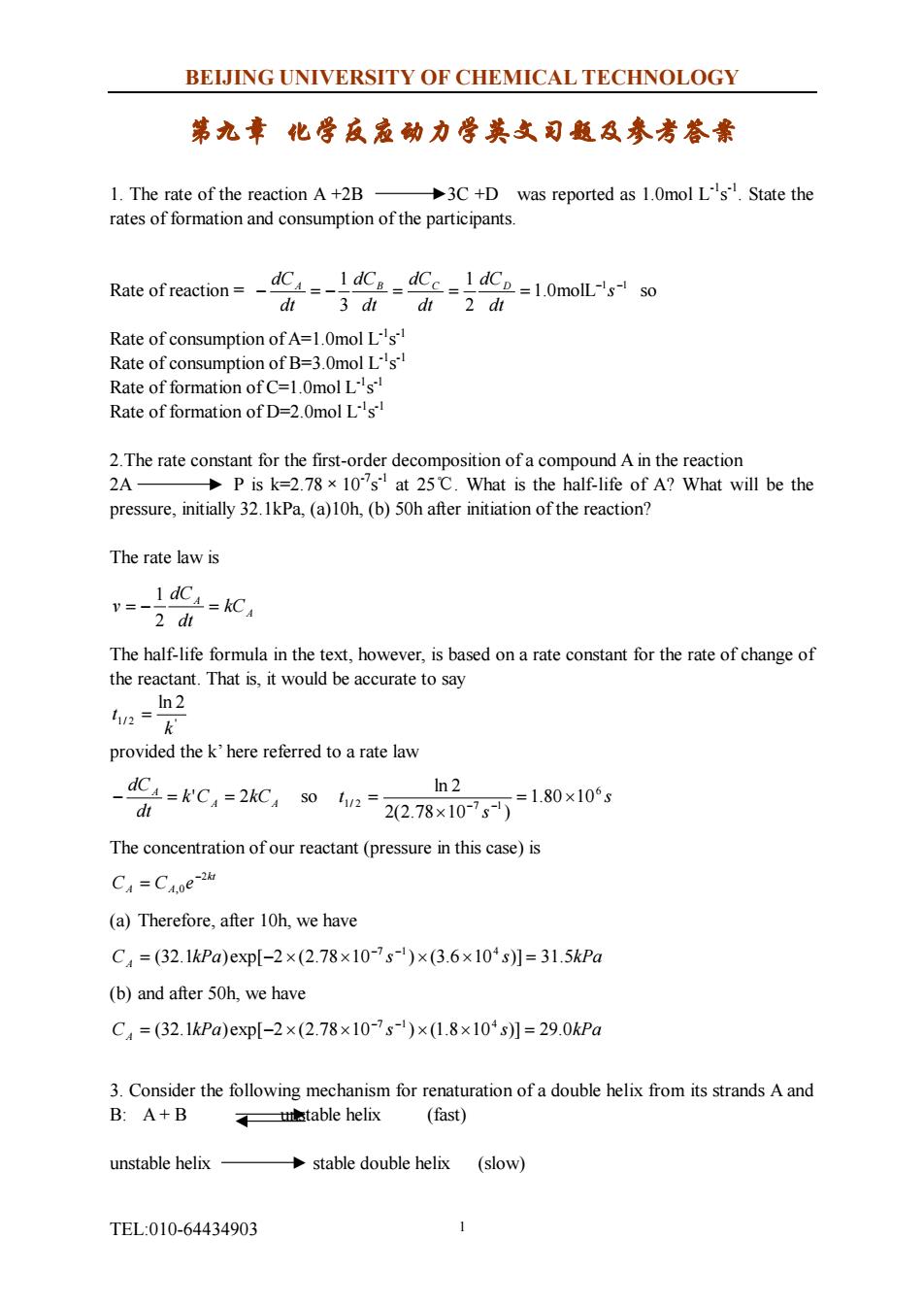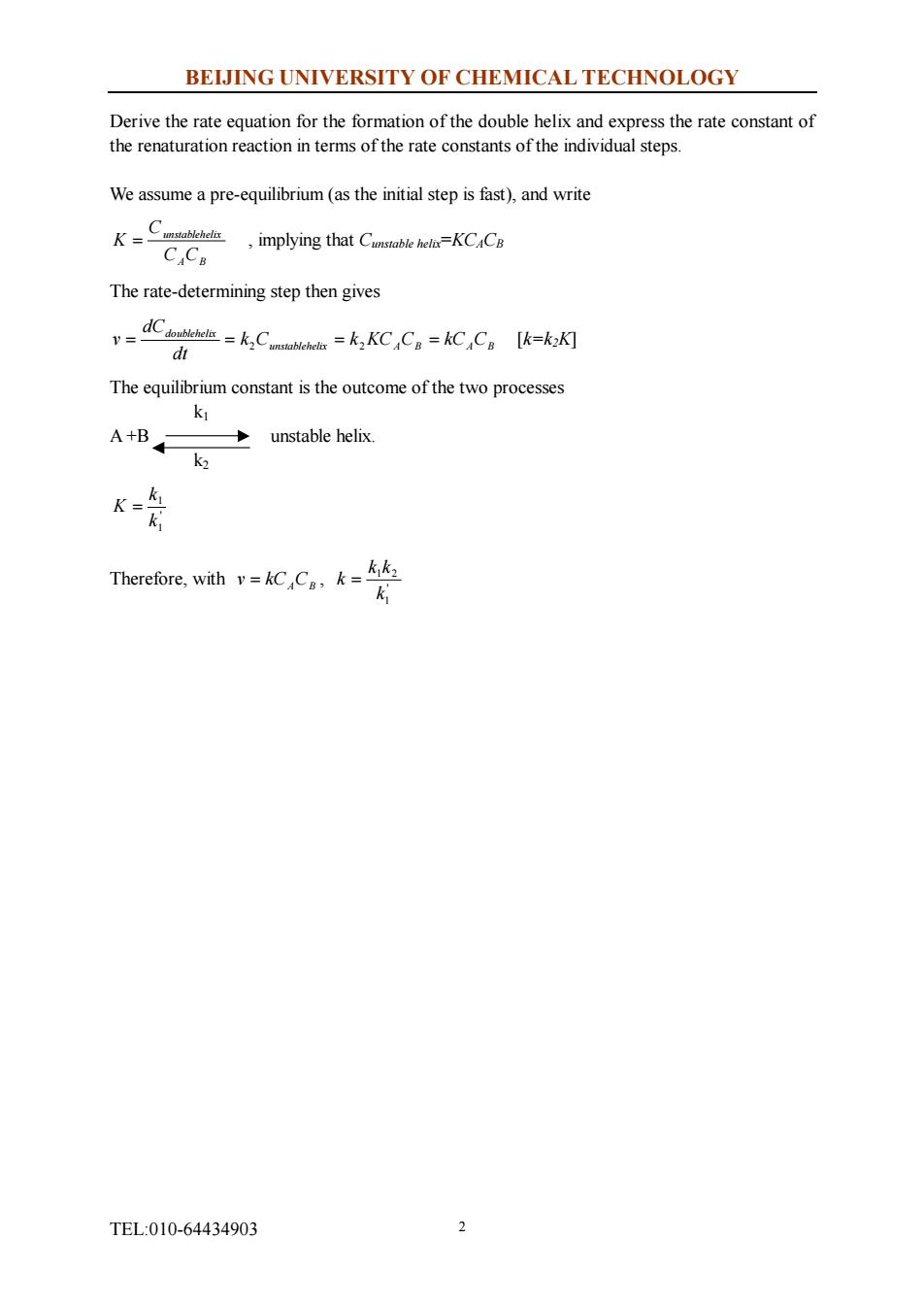
BEIJING UNIVERSITY OF CHEMICAL TECHNOLOGY 第九章化学反履的力学美文司题及参考答案 1.The rate of the reaction A+2B 3C+D was reported as 1.0mol Ls State the rates of formation and consumption of the participants Rate of reaction=- -1dCs=dCc=1dCp Rate of consumption ofA=1.0mol Rate of consumption of B=3.0mol Ls Rate of formation of C=1.0mol Ls Rate of formation of D=2.0mol Ls 2.The rate constant for the firs rder dec 2A und A in the reaction Pisk=2.7at 25C.What is the half-life of A?What will be the pressure,initially 32.1kPa,(a)10h,(b)50h after initiation of the reaction? The rate law is The half-life formula in the text,however,is based on a rate constant for the rate of change of the reactant.That is,it would be accurate to say a-2 provided the k'here referred to a rate law -G=kC,=2c,0n=327820可180x10: d The concentration of our reactant(pressure in this case)is C=CA0e2 (a)Therefore,after 10h,we have C4=(32.1kPa)exp-2×(2.78×10-s-)×(3.6×10-s月=31.5kPa (b)and after 50h,we have C4=(32.1kPa)exp[-2×(2.78×10-7s-)×1.8x104s】=29.0kPa 3.Consider the following mechanism for renaturation of a double helix from its strands A and B:A+B ttable helix (fast) unstable helix- stable double helix (slow) TEL:010-64434903 1
BEIJING UNIVERSITY OF CHEMICAL TECHNOLOGY TEL:010-64434903 1 第九章 化学反应动力学英文习题及参考答案 1. The rate of the reaction A +2B 3C +D was reported as 1.0mol L-1 s -1 . State the rates of formation and consumption of the participants. Rate of reaction = 1 1 1.0molL 2 1 3 1 - - - = - = = = s dt dC dt dC dt dC dt dCA B C D so Rate of consumption of A=1.0mol L-1 s -1 Rate of consumption of B=3.0mol L-1 s -1 Rate of formation of C=1.0mol L-1 s -1 Rate of formation of D=2.0mol L-1 s -1 2.The rate constant for the first-order decomposition of a compound A in the reaction 2A P is k=2.78×10-7s -1 at 25℃. What is the half-life of A? What will be the pressure, initially 32.1kPa, (a)10h, (b) 50h after initiation of the reaction? The rate law is A A kC dt dC v = - = 2 1 The half-life formula in the text, however, is based on a rate constant for the rate of change of the reactant. That is, it would be accurate to say 2 ' 1/ ln 2 k t = provided the k’ here referred to a rate law A A A k C kC dt dC - = ' = 2 so s s t 6 1/ 2 7 1 1.80 10 2(2.78 10 ) ln 2 = ´ ´ = - - The concentration of our reactant (pressure in this case) is kt A A C C e 2 ,0 - = (a) Therefore, after 10h, we have C kPa s s kPa A (32.1 )exp[ 2 (2.78 10 ) (3.6 10 )] 31.5 7 1 4 = - ´ ´ ´ ´ = - - (b) and after 50h, we have C kPa s s kPa A (32.1 )exp[ 2 (2.78 10 ) (1.8 10 )] 29.0 7 1 4 = - ´ ´ ´ ´ = - - 3. Consider the following mechanism for renaturation of a double helix from its strands A and B: A + B unstable helix (fast) unstable helix stable double helix (slow)

BEIJING UNIVERSITY OF CHEMICAL TECHNOLOGY Derive the rate equation for the formation of the double helix and express the rate constant of the renaturation reaction in terms of the rate constants of the individual steps. We assume a pre-equilibrium(as the initial step is fast),and write ,implying that hel=KCACg C.CR The rate-determining step then gives v=C=kC=kKC,C=kC,C。k=k灯 d The equilibrium constant is the outcome of the two processes k A+B unstable helix. k Therere.wh C..-答 TEL:010-64434903
BEIJING UNIVERSITY OF CHEMICAL TECHNOLOGY TEL:010-64434903 2 Derive the rate equation for the formation of the double helix and express the rate constant of the renaturation reaction in terms of the rate constants of the individual steps. We assume a pre-equilibrium (as the initial step is fast), and write A B unstablehelix C C C K = , implying that Cunstable helix=KCACB The rate-determining step then gives unstablehelix A B A B doublehelix k C k KC C kC C dt dC v = = 2 = 2 = [k=k2K] The equilibrium constant is the outcome of the two processes k1 A +B unstable helix. k2 ' 1 1 k k K = Therefore, with ACB v = kC , ' 1 1 2 k k k k =